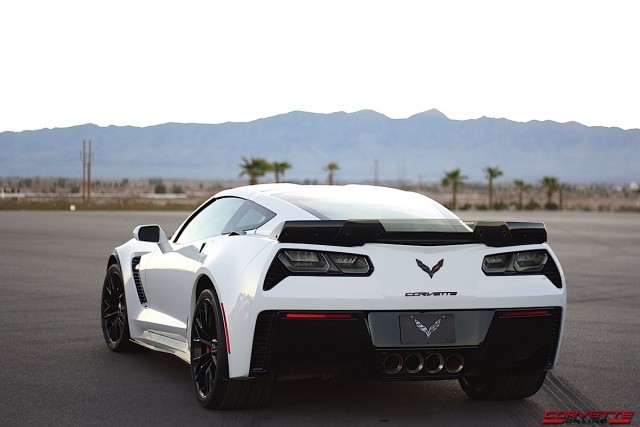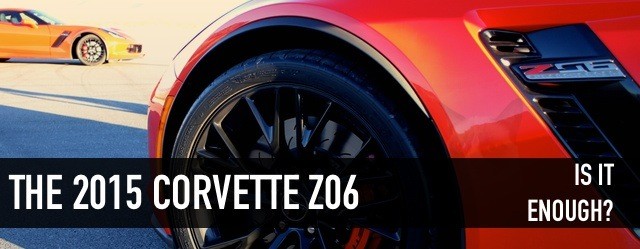 With the unveiling of Ford’s new 600-horsepower GT, the domestic marketplace once again has what many would consider a “proper” supercar. Mid-rear-engined and sleek, it fits the mold of the European exotics that America’s “other” supercar, the Corvette, never did. But there are rumors and spy shots hinting at an upcoming Chevy in that same idiom, a fulfillment of many decades of enthusiasts’ dreams.
With the unveiling of Ford’s new 600-horsepower GT, the domestic marketplace once again has what many would consider a “proper” supercar. Mid-rear-engined and sleek, it fits the mold of the European exotics that America’s “other” supercar, the Corvette, never did. But there are rumors and spy shots hinting at an upcoming Chevy in that same idiom, a fulfillment of many decades of enthusiasts’ dreams.
The reality of the new generation Ford GT, and the promise of a “Zora” mid-rear-engine Corvette model to come begs the question, “where does the 2015 Z06 fit in?” We got a chance to ask that question ourselves when Chevy offered the opportunity to drive the car at Nevada’s Spring Mountain Motorsports Ranch, both on-track and on public roads. Though we didn’t get as much time as we would have liked behind the wheel (you never really do at these sorts of things, but we’re still grateful for the experience), we did get a good sense of the car’s track performance and what it’s like to drive in the real world.
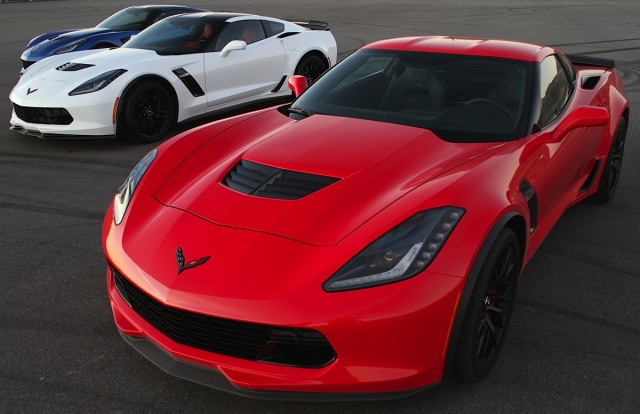
Over the course of two days, we got to experience Z06 Corvettes in standard, aero package, and Z07 trim, with both 7-speed manual and 8-speed automatic transmissions on the track and on public roads.
Process of Elimination
Perhaps the easiest question to answer is what the 2015 Z06 isn’t. While it will definitely outrun the laser-focused Z/28 Camaro even in that car’s home environment of the race track, it’s not an uncompromised track tool. In comparison to the previous generation Z06, even in its top-performing Z07 trim the 2015 Corvette isn’t as singleminded, which makes sense considering the current C7 product lineup, which is fundamentally different from the previous generation’s offerings.
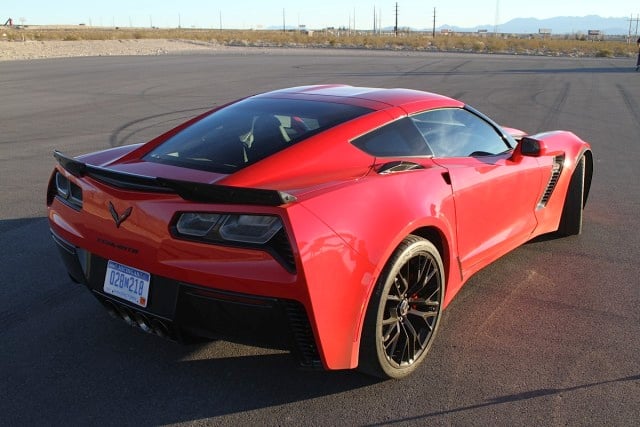
Look closely at the rear fender vent and you’ll notice the “air blade” – Chevy says these force about 50% more air through the cooling ducts for the differential and transmission than the standard Stingray. Convertible Z06’s get underbody inlets for the pair of coolers. Even though the Z07’s removable center spoiler section is clear smoked plastic, it doesn’t do any favors for rearward visibility, but fortunately there isn’t much on the road that can catch you from behind when you’re driving this car.
If you wanted a C6 to throw around a race track, you bought a Z06. If you wanted LS7 bragging rights and the wind in your hair, you bought a 427 Convertible. If you wanted the Maximum Chevy, you ordered up the ZR1. At this point in the C7’s life cycle, the Z06 is being asked to fill all those roles, and as such, it’s turned out to be a different kind of car than its predecessor.
If you wanted a C6 to throw around a race track, you bought a Z06. If you wanted LS7 bragging rights and the wind in your hair, you bought a 427 Convertible. If you wanted the Maximum Chevy, you ordered up the ZR1.
Some buyers will undoubtedly take a “check all the boxes” approach and order up the somewhat perverse combination of an auto-trans ‘vert outfitted with the Z07 package, which adds adjustable aero components, and Brembo carbon ceramic-matrix brake rotors that can haul the car down from 60 miles an hour in less than 100 feet. Then there are those Michelin Pilot Sport Cup 2 tires infused with very expensive witchcraft that allow a 1.2g steady state lateral acceleration. Even with every option selected, the C7 Z06 will still be a screaming bargain compared to cars with similar (or even inferior) performance that carry the “supercar” label.
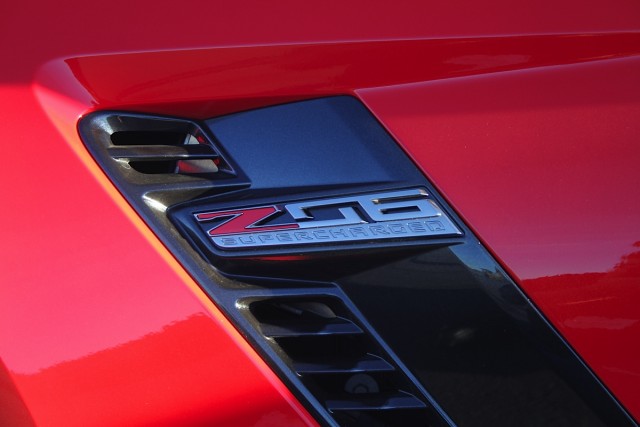
The star of the show is the 650 horsepower supercharged LT4 under the hood that provides performance that easily eclipses the C6 ZR1.
From the driver’s perspective, the Z06 definitely doesn’t give up anything to the C6 Z06 in terms of raw performance and track aptitude, especially in Z07 trim. It also surpasses the C6 ZR1 in the “Grand Touring” role, with all the comfort and refinement that buyers of a Corvette with a $100k-plus sticker will expect. But it doesn’t really define itself in either of those roles as clearly as the previous models, either – doing everything as well as it does also means that this is a Corvette seen through a wide angle lens, rather than a tight zoom.
Nowhere to Go But…
Understanding the Aero
There are three basic aerodynamic configurations for the Z06, each with its own tradeoffs in terms of drag and downforce. The standard Z06 differs from lesser Stingray models with a front splitter, spats around the front wheels to better streamline the wider tires, a carbon fiber hood with a larger vent than the naturally-aspirated car that’s unique to the Z06, and a rear spoiler.
The carbon-fiber aero package substitutes a carbon fiber splitter with “winglets” to direct airflow past the fenders, carbon fiber rocker panels, and a larger rear spoiler with a fixed “wickerbill.” Buyers can choose a black finish, or visible carbon fiber weave for these aero components.
Finally, the Z07 package adds larger front winglets and an adjustable see-through center section for the rear spoiler. This component comes delivered in the trunk, ostensibly “for track use,” but we suspect most owners will install it the moment they get the car home, and leave it installed.
Per GM, this package delivers the most aerodynamic downforce of any production car they’ve ever tested. Conversely, the “plain” Z06 offers the highest drag-limited top speed of the three available configurations, at the expense of being closer to “neutral” rather than developing significant net aerodynamic downforce.
After seven generations, will we finally get an “exotic” Corvette? Is the current Z06 something of a stop-gap for the time being, until the “Zora” can be brought to market? From a performance perspective, there’s nothing lacking from the current Stingray layout. The placement of the LT4, with its center of mass behind the front axle, and the transaxle layout that puts the gearbox at the back, offers a near perfect weight distribution, while a rear-mid layout would almost certainly bias weight toward the rear. Though this offers potential advantages for acceleration and braking and lowers the polar moment of inertia, it can have a negative influence on at-the-limit handling.
In terms of materials and construction, the C7 chassis utilizes an aluminum frame and extensive carbon fiber components, so there’s no clear advantage to be had there, short of F1-style monocoque composite construction. While this certainly is a feature of many supercars, it’s also not particularly well-suited to mass production and makes for difficult and expensive repairs. On the new GT, Ford seems to be hedging their bets with a composite center “tub” connecting aluminum subframes front and rear.
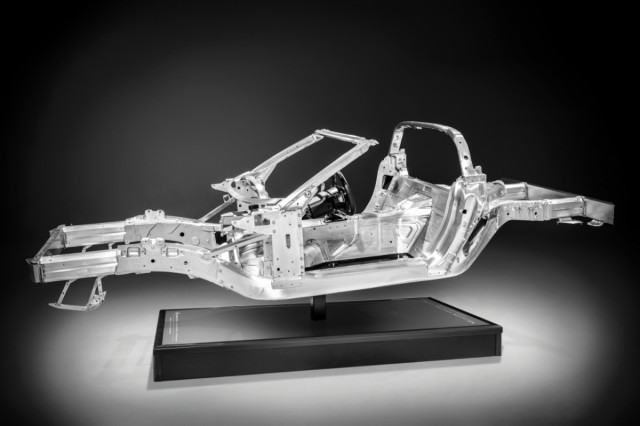
Unlike the C6 generation, which used a steel frame for the “base” model cars, the Z06 shares the same aluminum frame as its Stingray siblings.
What it comes down to, we suppose, is styling and exclusivity. There are some would-be buyers in the supercar market who insist that nothing that puts the engine ahead of the driver will ever do. For them, no matter how close to automotive perfection the current Corvette Z06 might be, it will never have the right attributes to compete with exotics from Lamborghini, Ferrari, McLaren, and yes, Ford.
The 2015 Z06 isn’t for them. It’s for us – an aspirational car that’s actually achievable, a sports car that will humiliate European imports that cost three times as much at the race track, and just as easily eat up miles on the interstate or sit in traffic with the air conditioning blasting and the temperature needle never causing alarm.
We say, “Let Chevy build the Zora.” For those of us who want as much car as we can get for the money, the Z06 is more than enough.
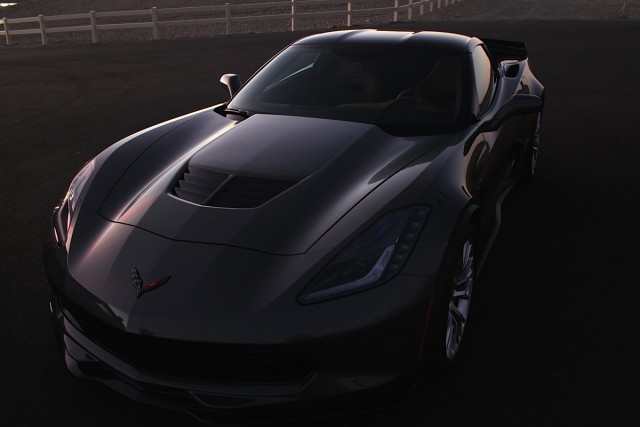
We still think black is the color that shows off the Stingray’s lines the best. Like an obsidian arrowhead…




